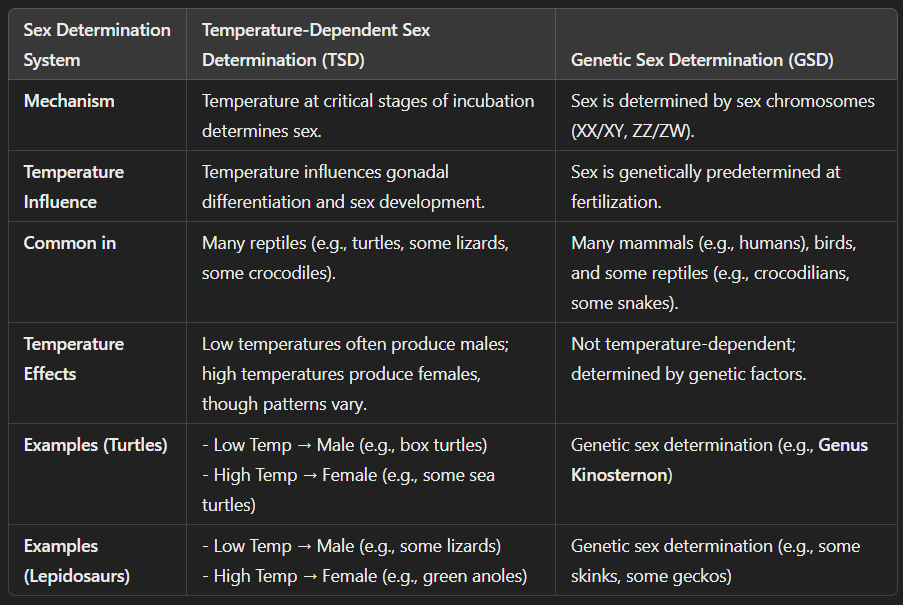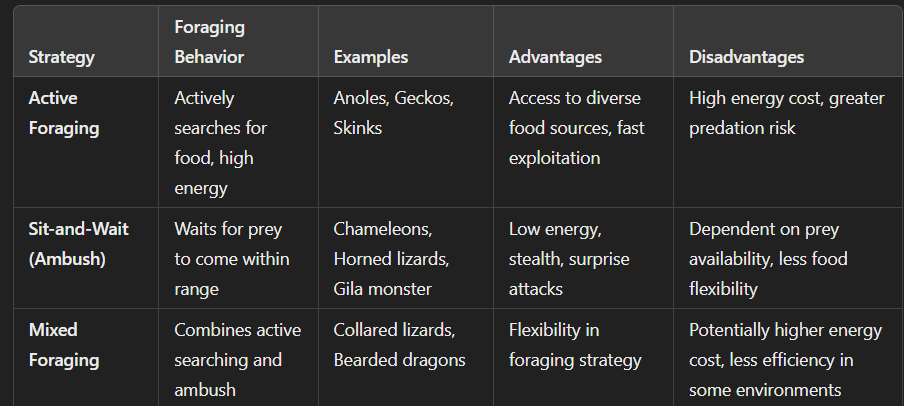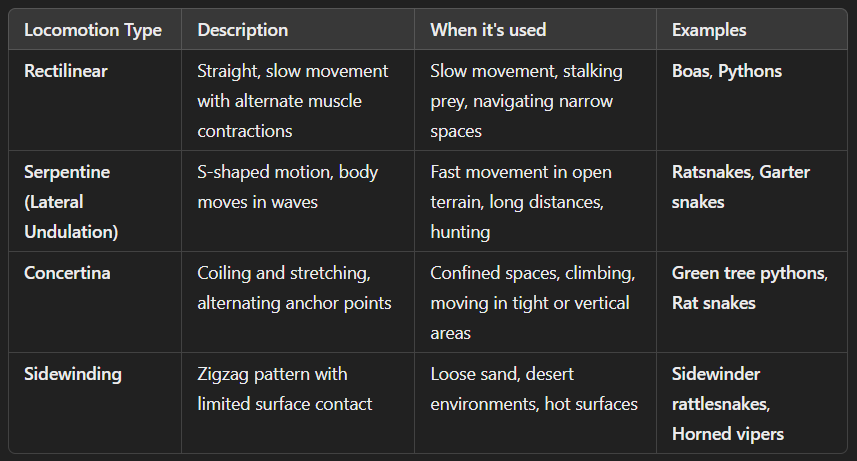Test 3 learning objectives
Phylogeny
Draw a phylogenetic tree depicting the relationships of the major vertebrate lineages we have covered in this course. Be sure you can recognize the following monophyletic groups: Cyclostomata, Myxiniformes, Petromyzontiformes, Chimaeriformes, Elasmobranchii, Coelacanthiformes, Dipnoi, Tetrapoda, Polypteriformes, Acipenseriformes, Lepisosteiformes, Amiiformes, Teleostei, Craniata, Vertebrata, Gnathostomata, Chondrichthyes, Osteichthyes, Sarcopterygii, Actinopterygii, Neopterygii, Gymnophiona, Urodela, Anura, Lissamphibia, Amniota, Sphenodontidae, Squamata, Lepidosauria, Testudines, Crocodilia, Aves, Archosauria, Sauropsida, Monotremata, Metatheria, Eutheria, Mammalia.
Amniotes
Diagram and label a generalized amniotic egg, discussing the function of each part. Describe the evolutionary significance of this egg.

Amnion: Protects the embryo by providing a stable environment and cushioning against mechanical shocks.
Chorion: Facilitates gas exchange between the embryo and the external environment.
Allantois: Stores waste products and plays a role in gas exchange; it also contributes to the formation of the umbilical cord in mammals.
Yolk sac: Provides nutrients to the developing embryo, containing the yolk, which is a rich source of energy.
Shell: Offers protection against desiccation and physical damage, while allowing for gas exchange.
Temporal fenestration patterns are an important aspect of amniote morphology. Explain their functional significance and how they correlate with phylogeny.
functional significance
closely related to the evolution of temporal fenestration, as these features allow for greater muscle attachment and efficiency in feeding strategies among various amniote lineages. Allows for more powerful jaw due to the ability to have larger muscles and greater surface for those muscles to attach
reduces skull weight by creating spaces where bones are eliminated or thinned and increases skull strength in reptiles without excessive bone mass
more robust reinforced skull because the bones are rearranged to provide strength where needed
phylogenetic correlation
anapsids
absence of temporal fenestrae (modern turtles), reflected ancestral condition of amniote skull
synapsids
have single temporal fenestra located behind the orbit, group includes the ancestors of modern mammals, evolution of a single temporal fenestra allowed for the development of a large temporalis muscle which makes more powerful bite and better masticatory efficiency
diapsids
have two temporal fenestrae, one above and one below the postorbital bone, seen in most reptiles, allows for even greater increase in jaw muscle size and efficiently contributing to the evolution of more diverse and specialized feeding strategies
evolutionary trends
The evolution of temporal fenestration patterns reflects the overall trend of amniote evolution towards more efficient skulls capable of supporting stronger and more complex jaw musculature. This transition allowed for greater specialization in feeding strategies, including more powerful bites, increased jaw mobility, and the evolution of various forms of dentition.
Over time, the changes in temporal fenestration also correlate with shifts in ecological niches, where more efficient feeding systems enabled the radiation of different groups into new habitats and dietary roles.
Compare and contrast strategies for respiration employed by the sauropsids and synapsids.
Sauropsids
reptiles have sac-like lung (faveolar lungs) with limited complexity, have unidirectional airflow
reptiles controlled by muscular movement rather than diaphgram, movement of ribs and other body muscles (like abdominal or intercostal muscles) to expand and contract the chest cavity creating a pressure difference that dirives air into the lungs
reptiles have low surface area in their lungs making respiration less efficient
Synapsids
mammals have lungs, divided into lobes and the contain alveoli which are primary sites for gas exchange. Alveolar lungs allow for a greater surface area for gas exchange compared to the sac-like lungs of reptiles, facilitating more efficient oxygen intake and carbon dioxide expulsion.
mammals rely on diaphragmatic ventilation where the diaphragm contracts and flattens to increase the volume of the thoracic cavity drawing air into the lungs, use intercostal muscles to assist with rib movement during ventilation
mammals have alveolar structure that is highly efficient
Endothermy has evolved multiple times within amniotes. Compare and contrast adaptations for endothermy seen in sauropsids and synapsids.
Sauropsids
Possess a unique arrangement of air sacs that allows for more efficient gas exchange during respiration, facilitating a higher metabolic rate.
Exhibit a more rigid body structure that conserves heat, alongside features such as feathers that provide insulation.
size and body shape, smaller animals have higher surface area to volume ratio which facilitates more heat loss but may require more energy to maintain body temp
countercurrent heat exchange in blood vessels
thermal regulatory behaviors like basking
Synapsids
high metabolic rate allowing them to generate enough heat to maintain a stable body temperature, endothermic
insulating fur, hair and fat retaining metabolic heat
sweating and panting for heat dissipation
adipose tissue, fat that is metabolically active and helps produce heat through non-shivering thermogenesis
thermoneutral zone, the range of temperatures where the body foes not need to expend energy to maintain its temperature
Testudines
Differentiate cryptodire from pleurodire turtles, citing examples of each.
Cryptodira: head straight back into their shell
Eastern box turtle
snapping turtle
red-eared slider
more domed shells, plastron structure is often more solidly attached in some species it has a hinge, more flexible and articulated vertebral column
Pleurodires: retract head sideways into the shell
Matamata turtle
southern snake-necked turtle
pond turtles
flatter shells, plastron structure is more rigid and does not have hinges, have more rigid and shorter neck
Describe the morphological nature of the turtle shell. What are some specific ways that some turtle lineages have modified their shells for particular adaptive purposes?
Carapace
formed by the fustion of the ribs and vertebrae with external bony or keratinous scutes, which provide protection and support. Additionally, some species have developed a more domed shape for enhanced defense against predators, while others have flattened shells to streamline their bodies for better swimming efficiency.
Plastron
flat and slightly convex structure that serves as a shield for the turtle’s underside and is composed of bony plates, in some species it is hinged
box turtles have hinged plastron that allow them to close their shell tighter and seal off the opening, it also has a dome shaped carapace that makes it harder for predators to get a grip and bite through
snapping turtles have a heavily armored carapace that is strong against predators, they have a smaller plastron that does not cover the whole body which means they have greater flexibility but less protective coverage
seaturtles have streamlined carapace designed to reduce drag while swimming, they have a flattened and reduced plastron allowing for greater flexibility and streamline movements
flattened carapace fir burrowing species to allow for easier digging
The unique morphology of turtles imposes challenges for respiration. What are the specific challenges and how have turtles adapted their respiratory strategy? (i.e. how do turtles breath?)
challenges
inflexible shells means that their ribs cannot more like other species to help with ventilation
limited ventilation difficultly creating negative pressure
reduced respiratory surface area since some have relatively small lungs compared to their body size
aquatic lifestyle need to breathe underwater
adaptations
muscular contracts to assist in ventilation by helping to create pressure changes in the body cavity and assist in moving air in and out of lungs
abdominal breathing, where abdominal and other body-wall muscles to explant and conpress lungs
cloacal respiration, where they extract oxygen from the water using the lining of the cloaca
some species of aquatic turtles use a form of buccal pumping that pumps air into the mouth and forces it into the lungs
low metabolic rate allows them to conserve oxygen and high myoglobin to store more oxygen
leather back turtles have large lungs to hold more oxygen, green turtles have more efficient gas exchange surfaces in their lungs that allows them to extract oxygen more efficiently during brief periods of surfacing
Describe the differences between temperature dependent sex determination and genetic sex determination. Which temperatures (high or low) lead to the development of males or females in turtles and lepidosaurs?
What are some of the possible evolutionary explanations for the origin of temperature dependent sex determination?
1. Adaptation to Changing Environments
Explanation: TSD may help species adapt to environmental changes by using temperature to determine sex, ensuring a balanced population.
Example: In reptiles like some turtles and crocodiles, higher temperatures produce females, while lower temperatures produce males. This can help balance the number of males and females in response to environmental conditions.
2. Manipulating Sex Ratios
Explanation: TSD can help control the ratio of males to females, which can be important for reproduction and survival.
Example: In some species, if environmental conditions favor one sex (e.g., females grow larger and have better reproductive success in warmer conditions), the population may produce more of that sex to maximize fitness.
3. Mate Availability
Explanation: TSD may match sex determination with the availability of mates, increasing the chances of successful reproduction.
Example: If males are more active or more likely to mate in cooler conditions, the temperature might favor the production of more males when conditions are right, ensuring there are enough mates for females.
4. Maternal Influence
Explanation: Females may influence the sex of their offspring by choosing warmer or cooler environments for their eggs, allowing them to adapt to fluctuating temperatures.
Example: Female sea turtles choose nest sites based on temperature. Warmer temperatures tend to produce more females, and cooler ones produce more males, giving mothers control over offspring sex depending on environmental factors.
5. Adapting to Environmental Stress
Explanation: TSD could be a way to help species cope with environmental stress by adjusting sex ratios in response to difficult conditions.
Example: If a species experiences a tough environment (e.g., extreme temperatures), producing a specific sex could increase the chances of survival or reproduction in that environment.
6. Transition from Environmental to Genetic Sex Determination
Explanation: TSD might have been an early evolutionary step before more stable genetic sex determination (where sex is determined by genes rather than temperature).
Example: Some animals that now have genetic sex determination might have once used temperature to determine sex, and over time, this evolved into a more predictable genetic system.
7. Improving Group Cooperation
Explanation: TSD may help species produce the sex that is most beneficial for cooperative behaviors (like nesting or territory defense).
Example: In some species, males may be needed for protection or hunting, while females may be crucial for caring for offspring. Temperature-dependent sex determination could ensure the right balance of males and females for group survival.
Marine turtles undergo massive migrations related to feeding and breeding. Describe the factors that drive this behavior and the navigational tools these turtle use to find their way.
Factors Driving Migrations:
Feeding Needs: Turtles migrate to areas with abundant food, such as seagrasses or jellyfish.
Example: Leatherback turtles travel long distances to feed on jellyfish in colder waters.
Breeding Needs: Females return to specific beaches to lay eggs, often the same beach where they were born.
Example: Green turtles migrate back to the beaches of their birth for nesting.
Temperature Preferences: Turtles seek optimal water temperatures for feeding or breeding.
Example: Some turtles breed in warmer waters and feed in cooler waters.
Ocean Currents and Water Quality: Turtles use ocean currents to travel and prefer certain water qualities for feeding or nesting.
Example: Loggerhead turtles use currents to help migrate across the Atlantic.
Reproductive Synchrony: Turtles nest during specific seasons when conditions (like sand temperature) are right for egg survival.
Navigational Tools Used by Marine Turtles:
Magnetic Field Detection (Geomagnetic Navigation): Turtles can sense Earth’s magnetic field to navigate long distances.
Example: Turtles return to their natal beaches using a "magnetic map" of the Earth’s field.
Sun Compass: Turtles use the sun's position to orient themselves during the day.
Example: Turtles use the sun to find direction when close to shore.
Wave and Current Cues: Turtles use wave patterns and ocean currents to guide their migrations.
Example: Turtles follow ocean currents to travel vast distances with less energy.
Odor (Chemical Cues): Turtles may use chemical cues in the water to help navigate.
Example: Chemical signals from algae or other marine organisms could guide turtles.
Visual Landmarks: Turtles use visual landmarks (e.g., coastline shape) when nearing nesting beaches.
Example: Female turtles use the shape of the coastline to find their nesting beach.
Lepidosauria
Discuss the significance of autotomy and pseudautotomy in lepidosaurs. How do they differ?
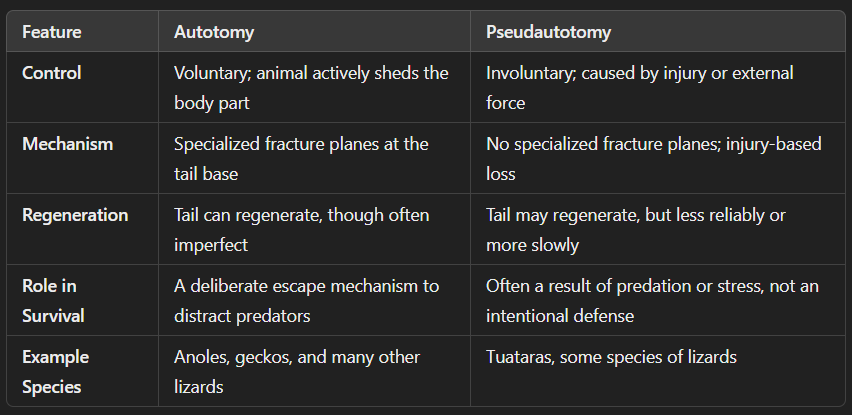
Autotomy is an evolved and intentional survival strategy that allows lepidosaurs to escape predators by shedding their tails, often accompanied by tail movement to confuse the predator. It is a highly adaptive mechanism that can be repeated, although the new tail may be less functional.
Pseudautotomy, on the other hand, occurs when a body part is lost accidentally, without the animal's control, often as a result of predation or stress. While it may lead to tail loss, it does not serve the same adaptive function as autotomy and is less reliable for escape.
Limb reduction or loss is a common them in lepidosaur evolution. Explain its importance in lepidosaur evolution, highlighting examples and describing how snakes fit this context.
Importance in Lepidosaur Evolution
Ecological Adaptation:
Burrowing: Limblessness aids in efficient burrowing and moving through narrow spaces.
Swimming: Streamlined bodies with reduced limbs allow better movement in water.
Predation: Limblessness can help with stealthy movement or prey capture in confined spaces.
Energy Efficiency: Fewer limbs reduce metabolic costs, focusing energy on key functions like locomotion and sensory systems.
Streamlined Body: Reduction in limbs leads to a more efficient, smooth body plan for movement in specific environments.
Simplification: Less complexity in body structure allows for evolutionary trade-offs, where energy is redirected from limb development to other traits.
Examples of Limb Reduction in Lepidosaurs
Snakes:
Fully limbless, evolved for burrowing, swimming, and serpentine movement.
Example: Pythons, boas, and cobras rely on their long, flexible bodies for movement through narrow spaces, often using lateral undulation to propel themselves.
Legless Lizards:
Legless or reduced-limbed species that resemble snakes but are technically lizards.
Example: Slow worms and glass lizards, which are adapted for burrowing or living under rocks.
Skinks:
Some species of skinks have reduced limbs, aiding in burrowing and living in sandy or rocky environments.
Example: The Tiliqua skink and Corucia zebrata have reduced limbs but retain the lizard-like body form.
How Snakes Fit This Context
Evolutionary Background: Snakes evolved from lizard-like ancestors with fully developed limbs, adapting to burrowing or swimming environments where limbs became redundant.
Functional Adaptations:
Serpentine Locomotion: Lateral undulation allows movement without the need for limbs.
Specialized Muscles and Scales: Belly scales and muscle adaptations help snakes move efficiently.
Ecological Niche: Limblessness helps snakes occupy diverse habitats (e.g., deserts, forests, and aquatic environments), improving hunting and survival.
We discussed three morphological consequences of body elongation in snakes. Describe the functional significance of these consequences.
Herbivory has evolved in several squamate lineages. What morphological characteristics accompany this diet specialization? Cite specific examples of herbivorous lizards to illustrate your answer.
Teeth:
Broad, flat teeth for grinding plant material.
Sharp, pointed teeth for tearing tough leaves.
Example: Iguanas (flat teeth for grinding), Spiny-tailed iguanas (sharp teeth for tearing).
Jaw Muscles:
Stronger jaw muscles to efficiently chew fibrous plant matter.
Example: Iguanas and Chuckwallas (strong jaw muscles for chewing tough plants).
Digestive System:
Longer intestines for better absorption of plant nutrients.
Enlarged caecum for fermentation of plant material.
Example: Iguanas have an enlarged cecum for fermentation of tough plants.
Body Size and Shape:
Larger bodies to process larger amounts of plant material.
Flattened or robust body for better access to plants.
Example: Chuckwallas (broad, flattened bodies for foraging).
Feeding Behavior:
Selective feeding on leaves, fruits, and flowers.
Example: Iguanas selectively feed on specific plants.
Limb and Tail Adaptations:
Strong, muscular limbs for climbing and accessing plants.
Muscular tails for balance while foraging.
Example: Iguanas have strong limbs for climbing trees.
Green Iguana: Primarily eats leaves, fruits, and flowers; large teeth, long intestines, strong jaw muscles.
Chuckwalla: Feeds on desert plants; broad body, robust limbs, strong jaw muscles.
Spiny-tailed Iguana: Consumes leaves and fruits; sharp teeth, strong jaw muscles.
Compare and contrast different foraging strategies employed by lizards.
Describe the two hypotheses for cause of death by constriction.
Compare and contrast opisthoglyphous, proteroglyphous, and solenoglyphous fang morphologies. Cite specific examples of which snake lineages exhibit each morphology.
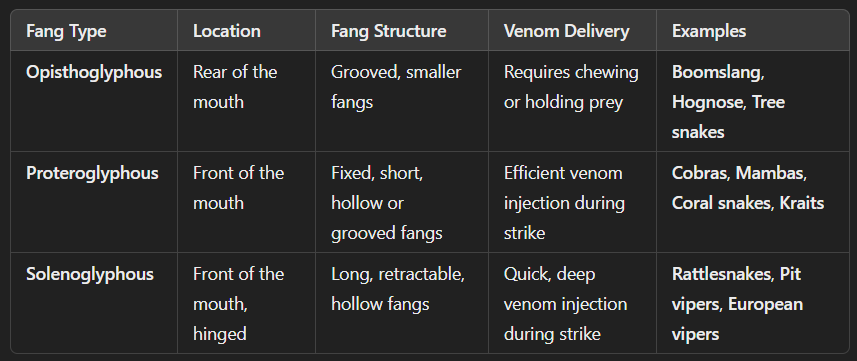
Fang Location:
Opisthoglyphous: Fangs at the rear of the jaw.
Proteroglyphous: Fangs at the front of the jaw.
Solenoglyphous: Fangs at the front with a retractable mechanism.
Fang Structure:
Opisthoglyphous: Grooved and smaller fangs.
Proteroglyphous: Fixed, short, hollow or grooved fangs.
Solenoglyphous: Long, retractable, hollow fangs.
Venom Delivery:
Opisthoglyphous: Requires chewing or holding prey for venom delivery.
Proteroglyphous: Efficient venom delivery through quick strikes.
Solenoglyphous: Rapid, deep venom injection during a strike with highly efficient delivery.
Examples:
Opisthoglyphous: Boomslang (Dispholidus typus), Hognose snakes (Heterodon).
Proteroglyphous: Cobras (Naja), Mambas (Dendroaspis).
Solenoglyphous: Rattlesnakes (Crotalus), Copperheads (Agkistrodon contortrix).
Discuss the four basic methods of snake locomotion we discussed in class. When do snakes use each of these locomotory strategies?
We discussed different mating systems seen in iguanian lizards. Compare and contrast these specific systems.
Describe parthenogenetic reproduction in the squamate genera Cnemidophorus and Aspidoscelis.
Discuss thermoregulatory strategies in Costa Rican Ameiva lizards.
Archosauria
Vocal, visual, and tactile communication are all important in archosaurian biology. Discuss how these forms of communication are exhibited in crocodilians.
1. Vocal Communication
Mating Calls: known to produce deep, resonant vocalizations during the breeding season. Male crocodiles, produce a "belly roar" or "low-frequency bellow" that can be heard over long distances. This call serves as a territorial marker to other males and as an invitation to females. It can be heard through the water, and its low frequency may travel far
Parental Communication: Females may produce softer, high-pitched vocalizations when they are near their nests, especially when their eggs are close to hatching. These sounds help facilitate the hatching process, as hatchlings can also make vocalizations to communicate with the mother. After hatching, young crocodiles continue to use vocalizations to seek protection or food from their mother.
Aggression and Threats: Crocodilians also use vocalizations in aggressive encounters with other animals. These may include growls, hisses, and barks, which serve to warn intruders or rivals to stay away from their territory.
2. Visual Communication
Visual communication plays a crucial role in signaling intentions, territory ownership, and reproductive status.
Postures and Display Behaviors: Crocodilians use distinct visual signals through body postures to communicate aggression, submission, and readiness to mate. For example, male crocodiles may perform an "arm waving" behavior, where they raise one forelimb in a display that signals dominance. This is often accompanied by vocalizations to increase its effectiveness.
Basking and Body Positioning: When basking on riverbanks or other surfaces, crocodilians often position themselves in ways that signal territoriality or social dominance. A crocodile that stretches its body out, keeping its head raised, may be signaling that it is a dominant individual, whereas one that keeps its head down and body closer to the ground might be signaling submission or less aggression.
Coloration: Some species of crocodilians exhibit subtle color changes or specific markings that can help with species identification and mating recognition. Although coloration is not as pronounced in crocodilians as in some other reptiles, there may be slight differences in hue that are used for social signaling.
3. Tactile Communication
Tactile communication is also important, especially in social interactions and bonding.
Mother-Offspring Interaction: One of the most prominent examples of tactile communication in crocodilians is the mother-offspring bond. After hatching, young crocodiles are often assisted by their mothers to the water by the mother gently carrying them in her mouth or on her back. This tactile contact helps keep the young safe and provides a physical bond between the mother and her offspring. Tactile contact is also used by mothers to move their hatchlings into safer locations.
Nesting and Grooming: While less common, some crocodilian species have been observed using tactile communication to maintain social bonds. For instance, during the nesting period, males may engage in tactile interactions with females to reinforce their pair bond or courtship. These interactions may involve the rubbing of snouts or gentle touches with the limbs.
Combat and Dominance Displays: When crocodilians engage in fights over territory or mates, tactile communication is central to their aggressive displays. These interactions involve physical contact, such as biting, pushing, or grappling, often accompanied by vocalizations. Dominant individuals may use physical force to establish territory or dominance.
How is parental care expressed in crocodilians? How does parental care inform the conclusion that crocodilians and birds are each other’s closest living relative?
Parental Care in Crocodilians
Nest Building and Protection: Female crocodilians typically build nests for their eggs, using vegetation, mud, and sand. The nest is carefully constructed to regulate the temperature of the eggs, ensuring optimal incubation conditions. In some species, males may also help with nest building.
Guarding the Nest: After laying the eggs, the mother (and sometimes the father) stays near the nest to guard it from potential predators, such as other animals or rival crocodilians. The mother may even make vocalizations to warn off threats.
Hatching and Assistance: When the eggs hatch, the mother often assists in breaking open the eggshells by gently using her mouth. Once the young crocodiles hatch, the mother may help them emerge from the nest by gently carrying them in her mouth and transporting them to water.
Care Post-Hatching: After hatching, crocodilian mothers continue to care for their offspring. Some species are known to protect their young for several months or even up to a year, offering them protection from predators. The mother may carry the babies in her mouth or even regurgitate food for them.
Vocalizations and Bonding: Both hatchlings and parents use vocalizations, which help maintain communication and facilitate bonding. Crocodilian hatchlings may vocalize while still inside their eggs to signal to their mother that they are ready to hatch.
Parental Care as Evidence for Crocodilian-Bird Relationship
The presence of complex and extended parental care in crocodilians is one of the key pieces of evidence supporting the idea that crocodilians and birds are closely related. The link between crocodilians and birds is supported by both morphological (structural) and behavioral similarities:
Parental Care in Birds: Birds are known for their sophisticated parental care, which includes building nests, incubating eggs, feeding, and protecting their chicks after hatching. In some bird species, both parents are involved in these activities, with the young receiving protection and care for a prolonged period.
Shared Parental Behaviors: The similarities in parental care between crocodilians and birds—such as nest building, guarding, and post-hatching care—suggest that these behaviors may have been inherited from a common ancestor. This form of parental investment is considered one of the shared traits that connect birds and crocodilians, supporting their inclusion in a group called Archosauria.
Evolutionary Implications: The strong parental care displayed by both crocodilians and birds suggests an evolutionary link, as these behaviors are less common in other reptile groups. This shared trait is part of a broader suite of similarities (including aspects of their anatomy, such as heart structure and the structure of their lungs) that point to a close evolutionary relationship.
Phylogenetic Evidence: Molecular data, as well as fossil evidence, also support the idea that birds are the modern descendants of theropod dinosaurs, which are part of the archosaur group. The fact that both crocodilians and birds share such advanced forms of parental care strengthens the hypothesis that birds are the closest living relatives of crocodilians, with both groups evolving from a common archosaur ancestor.
Mammalia
What distinctive features make mammals unique among vertebrates? How are these features functionally important?
1. Lactation (Mammary Glands)
Function: Lactation is a defining feature of mammals, enabled by the mammary glands, which produce milk to nourish offspring.
Nutritional Support: Milk provides essential nutrients such as fats, proteins, and carbohydrates in an easily digestible form. This helps young mammals grow quickly and develop the immune system through antibodies present in the milk.
Immune Protection: Colostrum, the first milk produced, is rich in antibodies, offering passive immunity to newborns, which is crucial in protecting them from infections during early life.
Evolutionary Advantage: This method of providing nourishment directly to the young has allowed mammals to evolve more complex reproductive strategies, ensuring higher survival rates for offspring.
2. Epiphyseal Plates (Growth Plates)
Function: Epiphyseal plates are areas of cartilage located at the ends of long bones in young mammals. These plates allow for growth in bone length during development.
Growth Regulation: As an individual matures, these plates gradually ossify (turn into bone), ceasing growth once the individual reaches maturity. This enables mammals to grow to a specific size.
Developmental Control: The epiphyseal plates also contribute to maintaining the flexibility needed for movement during growth, while gradually solidifying to form stronger, adult bones once growth is complete.
3. Cranial Morphology (Skull Structure)
Function: Mammals have a highly specialized cranial structure, which includes features such as a single lower jaw bone (the dentary), a well-developed braincase, and a complex structure of the inner ear.
Jaw and Teeth: The presence of a single lower jaw bone (dentary) in mammals, unlike reptiles, is important for efficient chewing and feeding. The arrangement of teeth (heterodont dentition) reflects dietary specialization.
Brain and Sensory Processing: The cranial cavity is large relative to body size in mammals, providing space for a larger brain. This supports advanced cognitive functions, sensory processing, and communication.
Ear Structure: Mammals have three ossicles (small bones) in the middle ear, crucial for amplifying sound, which enhances hearing capabilities, particularly important for mammals' diverse communication and environmental interaction.
4. Integumentary System (Skin, Hair, and Glands)
Function: The integumentary system in mammals includes skin, hair, and associated glands such as sebaceous (oil) glands, sweat glands, and mammary glands.
Hair for Insulation: Hair provides thermal insulation, protecting mammals from temperature extremes. It also helps in sensory functions (whiskers or vibrissae) and can play a role in camouflage or communication.
Glands for Homeostasis: Sweat glands, in particular, enable thermoregulation through evaporation. Sebaceous glands lubricate hair and skin, preventing dryness. The skin also acts as a barrier to pathogens and environmental stressors.
Adaptability: Hair and skin adaptations allow mammals to thrive in a wide range of habitats and climates, from the coldest arctic regions to the hottest deserts.
5. Erythrocytes (Red Blood Cells)
Function: Mammalian erythrocytes (red blood cells) are distinctive in that they lack a nucleus, unlike those of most other vertebrates. This provides them with greater flexibility and efficiency in oxygen transport.
Increased Oxygen Capacity: The absence of a nucleus increases the surface area available for hemoglobin, improving the cells' ability to carry oxygen. This is particularly important for mammals, given their high metabolic rates.
Efficient Blood Flow: The biconcave shape of erythrocytes allows them to move easily through narrow capillaries, optimizing oxygen delivery to tissues and maintaining high metabolic demands.
Summary of Functional Importance:
These features contribute significantly to the success of mammals:
Lactation ensures offspring receive the nourishment and immune protection needed for survival.
Epiphyseal plates control growth and ensure proper skeletal development.
Cranial morphology supports brain size, sensory capabilities, and efficient feeding and communication.
The integumentary system (hair and skin) supports thermoregulation, protection, and sensory input.
Erythrocytes maximize oxygen transport efficiency, supporting mammals’ high-energy lifestyles.
The mammalian integument contains a complex array of structures. Describe the major features we discussed in class.
- integument
- componenets
- hair: keratin derived structure
- camouglage
- communication
- sensation - vibrissae
- whiskers, long hairs attached to receptors
- primary function is insulation
- arrector pili muscles: when contracted it will pull the hair up
- hair properties
- exposed portion is nonliving
- color dependent on melanin
- molting: replacing hair at different times of the year
- sebaceous glands
- entire body
- sebum
- associated with follicles
- secretes oil
- Apocrine glands
- chemical communication
- ear wax
- eccrine glands
- watery secretion
- concentrated on area of contact
- sweat glands
Compare and contrast reproduction in the monotremes, metatherians, and eutherians. As a part of your answer, be sure to make specific reference to relative time of gestation and lactation.
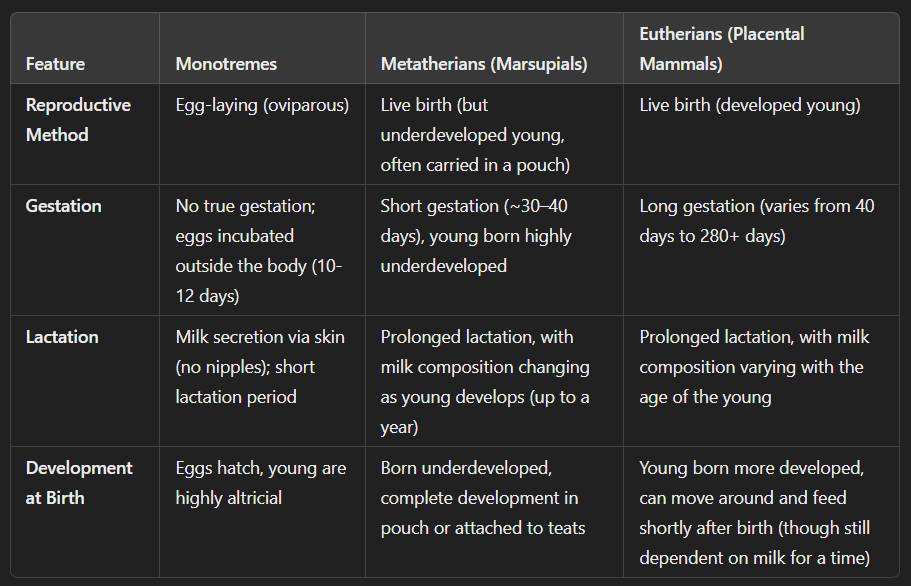
Functional Importance of Differences:
Monotremes:
Their egg-laying method reflects their more primitive mammalian lineage and provides a slower rate of offspring production. The short period of lactation, followed by the absence of nipples, shows how these animals are adapted to their specific environments (often solitary, low-maintenance maternal care).
Marsupials:
The short gestation in marsupials allows for rapid reproduction in environments where resources can be scarce or where a quick reproductive cycle is beneficial. However, the young are born highly underdeveloped, which means they rely heavily on the mother's milk for survival and further development. The pouch offers physical protection while the young continue to grow, adapting to both maternal care and external environmental pressures.
Eutherians:
Long gestation periods in eutherians allow the young to be born at a more developed stage, increasing their chances of survival immediately after birth. This is particularly advantageous in complex and competitive environments where survival after birth depends on a relatively high level of self-sufficiency. The placenta is key to this extended gestation, facilitating nutrient exchange and waste removal efficiently, which also allows for larger, more complex brains and higher metabolic rates in the young.
Discuss the challenges posed by an herbivorous diet and the two strategies mammalian herbivores employ to overcome these challenges in terms of morphology and physiology.
Challenges Posed by an Herbivorous Diet:
Cellulose Digestion:
Cellulose, a major component of plant cell walls, is indigestible by most mammals' own enzymes because they lack the ability to break down the β-linkages in cellulose. This means herbivores must rely on symbiotic microorganisms (bacteria, protozoa) to break down cellulose through fermentation.
Large Food Intake:
Plants are not as energy-dense as animal tissue. As a result, herbivores must consume large quantities of food to meet their nutritional and energy needs.
Nutrient Extraction:
Plants contain essential nutrients like carbohydrates, proteins, and minerals, but they are often difficult to access or in low concentrations compared to animal tissue. Herbivores must be efficient in extracting these nutrients.
Toughness of Plant Material:
Many plants are fibrous and tough, requiring herbivores to chew thoroughly and break down plant cell walls before digestion can occur.
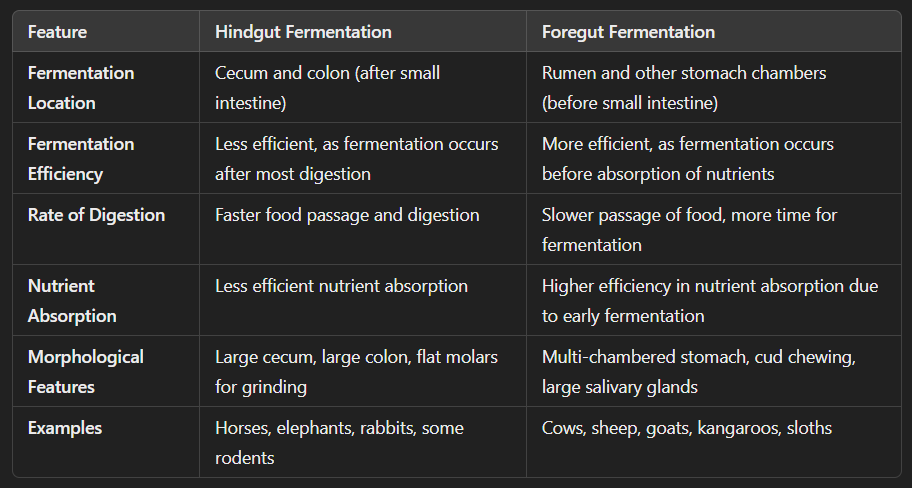
Summary of Strategies:
Hindgut fermentation allows herbivores to quickly process large amounts of food but at the cost of less efficient nutrient extraction. This strategy is often found in animals with fast metabolism and high food intake rates, such as horses and elephants.
Foregut fermentation allows for more efficient digestion of plant material, as the fermentation process occurs before nutrient absorption. However, this strategy requires a more complex and slower digestive system, often resulting in longer digestion times. Animals such as cows, sheep, and kangaroos use this method to maximize nutrient extraction from their plant-based diet.
Compare and contrast the two types of placentation seen in Mammalia and how they are expressed in both the metatherians and eutherians.
Summary of Key Differences:
Metatherians (marsupials) generally have epitheliochorial placentation, characterized by a relatively simple placenta with a minimal interaction between maternal and fetal tissues. As a result, marsupials have shorter gestation periods and give birth to underdeveloped young, which then continue developing outside the womb in a pouch or attached to the mother's teat.
Eutherians (placental mammals) have hemochorial placentation, where the fetal tissues directly interact with the maternal blood. This allows for a more efficient exchange of nutrients and gases, supporting longer gestation periods and the birth of more developed young.
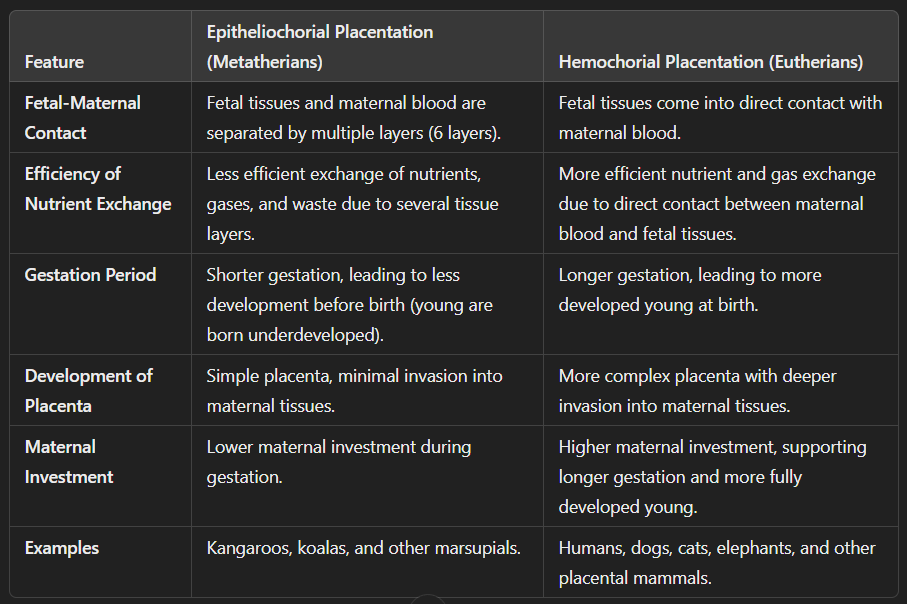
Additional material
You may also be asked to use diagrams as a part of your response or label diagrams. Be sure to review any and all diagrams completed in class.
There may be additional questions from our discussion of the Parsons et al. (2022) paper.
